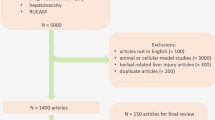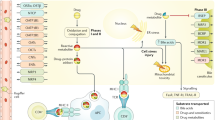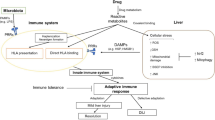Abstract
Isoniazid (INH) can cause serious idiosyncratic liver injury. An animal model would greatly facilitate mechanistic studies, but it is essential that the mechanism in the model be similar to the liver injury that can occur in humans. We attempted to replicate a previous study in which Wistar rats treated with INH and rifampicin (RMP) developed liver injury, which was promising because of its delayed onset similar to the liver injury that can occur in humans. Wistar rats were treated with either a high dose of INH (150 mg/kg/day) or a combination of INH and RMP (75 mg/kg/day and 50 mg/kg/day, respectively) for up to 4 weeks. However, we did not observe any liver injury or evidence of an inflammatory infiltrate as had been reported; rather, we observed an increase in CTLA4-positive cells in the cervical lymph nodes as well as a decrease in serum CXCL1 and MCP-1. In short, we were unable to reproduce a previously reported model of delayed onset INH-induced liver injury in Wistar rats.





Similar content being viewed by others
References
Maddrey WC, Boitnott JK (1973) Isoniazid hepatitis. Ann Intern Med 79:1–12
Centers for Disease C and Prevention (2010) Severe isoniazid-associated liver injuries among persons being treated for latent tuberculosis infection—United States, 2004–2008. MMWR Morb Mortal Wkly Rep 59:224–229
Mitchell JR, Zimmerman HJ, Ishak KG, Thorgeirsson UP, Timbrell JA, Snodgrass WR, Nelson SD (1976) Isoniazid liver injury: clinical spectrum, pathology, and probable pathogenesis. Ann Intern Med 84:181–192
Noda A, Hsu KY, Noda H, Yamamoto Y, Kurozumi T (1983) Is isoniazid-hepatotoxicity induced by the metabolite, hydrazine? J UOEH 5:183–190
Sarich TC, Youssefi M, Zhou T, Adams SP, Wall RA, Wright JM (1996) Role of hydrazine in the mechanism of isoniazid hepatotoxicity in rabbits. Arch Toxicol 70:835–840
Steele MA, Burk RF, DesPrez RM (1991) Toxic hepatitis with isoniazid and rifampin. A meta-analysis. Chest 99:465–471
Sarich TC, Zhou T, Adams SP, Bain AI, Wall RA, Wright JM (1995) A model of isoniazid-induced hepatotoxicity in rabbits. J Pharmacol Toxicol Methods 34:109–116
Blair IA, Mansilla Tinoco R, Brodie MJ, Clare RA, Dollery CT, Timbrell JA, Beever IA (1985) Plasma hydrazine concentrations in man after isoniazid and hydralazine administration. Hum Toxicol 4:195–202
Gent WL, Seifart HI, Parkin DP, Donald PR, Lamprecht JH (1992) Factors in hydrazine formation from isoniazid by paediatric and adult tuberculosis patients. Eur J Clin Pharmacol 43:131–136
Metushi IG, Nakagawa T, Uetrecht J (2012) Direct oxidation and covalent binding of isoniazid to rodent liver and human hepatic microsomes: humans are more like mice than rats. Chem Res Toxicol 25:2567–2576
Li J, Uetrecht JP (2009) d-penicillamine-induced autoimmunity: relationship to macrophage activation. Chem Res Toxicol 22:1526–1533. doi:10.1021/tx900128p
Metushi IG, Cai P, Zhu X, Nakagawa T, Uetrecht JP (2011) A fresh look at the mechanism of isoniazid-induced hepatotoxicity. Clin Pharmacol Ther 89:911–914
Metushi IG, Sanders C, Lee WM, Uetrecht J (2013) Detection of anti-isoniazid and anti-cyp antibodies in patients with isoniazid-induced liver failure. Hepatology. doi:10.1002/hep.26564
Sodhi CP, Rana SV, Mehta SK, Vaiphei K, Attari S, Mehta S (1997) Study of oxidative-stress in isoniazid-rifampicin induced hepatic injury in young rats. Drug Chem Toxicol 20:255–269
Tasduq SA, Kaiser P, Sharma SC, Johri RK (2007) Potentiation of isoniazid-induced liver toxicity by rifampicin in a combinational therapy of antitubercular drugs (rifampicin, isoniazid and pyrazinamide) in Wistar rats: a toxicity profile study. Hepatol Res 37:845–853
Rana SV, Pal R, Vaiphie K, Singh K (2006) Effect of different oral doses of isoniazid-rifampicin in rats. Mol Cell Biochem 289:39–47
Sodhi CP, Rana SV, Mehta SK, Vaiphei K, Attri S, Thakur S, Mehta S (1996) Study of oxidative stress in isoniazid-induced hepatic injury in young rats with and without protein-energy malnutrition. J Biochem Toxicol 11:139–146
Sodhi CP, Rana SF, Attri S, Mehta S, Yaiphei K, Mehta SK (1998) Oxidative-hepatic injury of isoniazid-rifampicin in young rats subjected to protein and energy malnutrition. Drug Chem Toxicol 21:305–317
O’Brien PJ, Slaughter MR, Polley SR, Kramer K (2002) Advantages of glutamate dehydrogenase as a blood biomarker of acute hepatic injury in rats. Lab Anim 36:313–321
Ng W, Lobach AR, Zhu X, Chen X, Liu F, Metushi IG, Sharma A, Li J, Cai P, Ip J, Novalen M, Popovic M, Zhang X, Tanino T, Nakagawa T, Li Y, Uetrecht J (2012) Animal models of idiosyncratic drug reactions. Adv Pharmacol 63:81–135
Warrington RJ, Olivier SL (1979) Lymphocyte-mediated cytotoxicity in isoniazid-associated hepatitis. Clin Exp Immunol 38:561–567
Foureau DM, Walling TL, DE Kleiner, Ahrens WA, Jacobs WC, McKillop IH, Barnhart HX, Serrano J, Bankovsky H (2012) Profiles of leukocytes infiltrating livers of subjects with drug-induced liver injury (DILI). Hepatology 56:596A (Abst 827)
Pardoll DM (2012) The blockade of immune checkpoints in cancer immunotherapy. Nat Rev Cancer 12:252–264
Jones SA, Moore LB, Shenk JL, Wisely GB, Hamilton GA, McKee DD, Tomkinson NC, LeCluyse EL, Lambert MH, Willson TM, Kliewer SA, Moore JT (2000) The pregnane X receptor: a promiscuous xenobiotic receptor that has diverged during evolution. Mol Endocrinol 14:27–39
Lehmann JM, McKee DD, Watson MA, Willson TM, Moore JT, Kliewer SA (1998) The human orphan nuclear receptor PXR is activated by compounds that regulate CYP3A4 gene expression and cause drug interactions. J Clin Investig 102:1016–1023
Li F, Lu J, Cheng J, Wang L, Matsubara T, Csanaky IL, Klaassen CD, Gonzalez FJ, Ma X (2013) Human PXR modulates hepatotoxicity associated with rifampicin and isoniazid co-therapy. Nat Med 19:418–420
Warrington RJ, Tse KS, Gorski BA, Schwenk R, Sehon AH (1978) Evaluation of isoniazid-associated hepatitis by immunological tests. Clin Exp Immunol 32:97–104
Warrington RJ, McPhilips-Feener S, Rutherford WJ (1982) The predictive value of the lymphocyte transformation test in isoniazid-associated hepatitis. Clin Allergy 12:217–222
Huang YS, Chern HD, Su WJ, Wu JC, Lai SL, Yang SY, Chang FY, Lee SD (2002) Polymorphism of the N-acetyltransferase 2 gene as a susceptibility risk factor for antituberculosis drug-induced hepatitis. Hepatology 35:883–889
Acknowledgments
Jack Uetrecht serves as Canada Research Chair in Adverse Drug Reactions. Imir G. Metushi is a trainee of the Drug Safety and Effectiveness Cross Disciplinary Training Program which is funded by the Canadian Institutes for Health Research. The operating funds for this research were also supplied by the Canadian Institutes for Health Research. We also thank Winnie Ng for helping with the optimization of the antibodies for flow cytometry and Kristin Wohanka for helping with the rat treatment.
Conflict of Interest
The authors have no conflict of interest.
Author information
Authors and Affiliations
Corresponding author
Rights and permissions
About this article
Cite this article
Metushi, I.G., Uetrecht, J. Lack of liver injury in Wistar rats treated with the combination of isoniazid and rifampicin. Mol Cell Biochem 387, 9–17 (2014). https://doi.org/10.1007/s11010-013-1864-7
Received:
Accepted:
Published:
Issue Date:
DOI: https://doi.org/10.1007/s11010-013-1864-7




